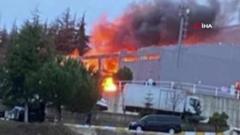The incident claims 38 lives, and investigations point to potential involvement of Russian military systems.
**Kazakhstan Plane Crash: Tragedy and Investigations Unfold**

**Kazakhstan Plane Crash: Tragedy and Investigations Unfold**
A passenger plane crash near Aktau, Kazakhstan, raises questions about air safety and defense systems.
In a tragic aviation incident, an Embraer 190 operated by Azerbaijan Airlines crashed near Aktau, Kazakhstan, while en route from Baku to Grozny, Russia. The disaster occurred on a routine flight on Wednesday, leading to the death of 38 passengers, while 29 people, including crew members, survived. The wreckage of the aircraft was found severely burned along the Caspian Sea's coast.
Authorities from Azerbaijan, Kazakhstan, and Russia have launched extensive investigations to uncover the circumstances surrounding the crash. Preliminary inquiries by Azerbaijani investigators suggest the likelihood that the aircraft may have been impacted by a Russian Pantsir-S1 air defense system at a point close to Grozny. This information, however, has not been officially confirmed, and investigators are still gathering all relevant facts.
Conflicting reports have emerged from Russian officials regarding the circumstances of the crash. Initially, they asserted that the aircraft was diverted due to fog and was struck by birds. As the investigation proceeded, their narrative evolved to indicate that attempts were made to clear the airspace around Grozny due to reports of Ukrainian drone activity in the area. They also mentioned two unsuccessful landing attempts made by the aircraft prior to the crash.
In the aftermath of the incident, several lawmakers in Azerbaijan have voiced their concerns, calling for an apology from Russia and a comprehensive investigation into the matter. The convergence of military activities in the region, particularly aerial conflicts involving Ukraine, has raised alarm bells about civilian aircraft safety flying through contested airspace.
As the investigation continues, attention will be focused on the role of military operations and air defense protocols in civilian flight safety, with ramifications for future aviation policies in airspace above active conflict areas.
Authorities from Azerbaijan, Kazakhstan, and Russia have launched extensive investigations to uncover the circumstances surrounding the crash. Preliminary inquiries by Azerbaijani investigators suggest the likelihood that the aircraft may have been impacted by a Russian Pantsir-S1 air defense system at a point close to Grozny. This information, however, has not been officially confirmed, and investigators are still gathering all relevant facts.
Conflicting reports have emerged from Russian officials regarding the circumstances of the crash. Initially, they asserted that the aircraft was diverted due to fog and was struck by birds. As the investigation proceeded, their narrative evolved to indicate that attempts were made to clear the airspace around Grozny due to reports of Ukrainian drone activity in the area. They also mentioned two unsuccessful landing attempts made by the aircraft prior to the crash.
In the aftermath of the incident, several lawmakers in Azerbaijan have voiced their concerns, calling for an apology from Russia and a comprehensive investigation into the matter. The convergence of military activities in the region, particularly aerial conflicts involving Ukraine, has raised alarm bells about civilian aircraft safety flying through contested airspace.
As the investigation continues, attention will be focused on the role of military operations and air defense protocols in civilian flight safety, with ramifications for future aviation policies in airspace above active conflict areas.





















